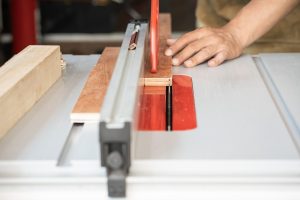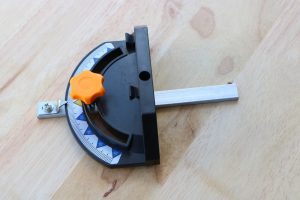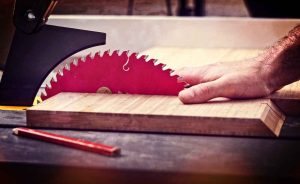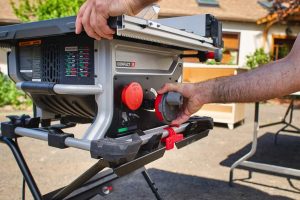A portable table saw is one of the most versatile tools in a woodworker’s arsenal. Compact yet powerful, it brings the capabilities of a stationary table saw to virtually any worksite, making it perfect for on-the-go projects, DIY enthusiasts, and even professional contractors.
But while a portable table saw opens up endless possibilities for precision cuts and efficient woodworking, it’s essential to understand how to use a portable table saw effectively.
Mastering a portable table saw doesn’t just ensure safety; it also allows for cleaner cuts, more accurate measurements, and faster project completion.
Whether you’re building furniture, trimming lumber, or tackling a home improvement task, a portable table saw can elevate your woodworking skills if you know how to handle it properly.
What is a Portable Table Saw?
A portable table saw is a compact and mobile version of the traditional stationary table saw, designed specifically for convenience and easy transport without compromising power or functionality.
Unlike the bulky, fixed table saws commonly found in workshops, portable table saws are lightweight, often featuring foldable stands or compact bases that make them perfect for both on-the-go jobs and small workspaces.
Portable Table Saw Benefits
The key benefits of a portable table saw include its compactness and portability, which allow woodworkers and DIY enthusiasts to bring it to job sites or move it around with ease.
Despite their smaller size, many portable table saws still offer impressive power, capable of cutting through various types of wood and even harder materials with precision.
This blend of power and portability makes them ideal for projects that require mobility without sacrificing cutting accuracy.
Ideal Uses
Portable table saws are versatile tools well-suited for construction sites, where setup and teardown need to be quick, as well as for home-based woodworking and DIY projects. Whether you’re tackling a major renovation or a simple furniture build, a portable table saw provides the features and functionality required to make precise cuts in any setting.
Essential Parts of a Portable Table Saw
Understanding the essential parts of a portable table saw is crucial for both effective and safe operation. Each component plays a specific role in ensuring the saw performs optimally while keeping the user protected. Below are the key parts of a portable table saw:
Blade
The blade is the cutting edge of the table saw and typically comes in various sizes and tooth counts to suit different materials and types of cuts. The height and angle of the blade can often be adjusted for different cutting requirements, such as rip cuts or bevels.
Rip Fence
The rip fence is a guide that runs parallel to the blade, helping maintain consistent, straight cuts by stabilizing and aligning the material. Adjusting the rip fence accurately is essential for precise cuts, especially during rip cuts where long, straight lines are needed.
Miter Gauge
The miter gauge is a small, adjustable guide used to make crosscuts at various angles. Placed in a slot on the table, it allows for more accurate angled cuts and is particularly useful when making cuts that require precise angles, such as miter joints.
Blade Guard
The blade guard covers the blade and acts as a barrier to prevent accidental contact. Many blade guards are clear, allowing users to see the blade without putting their hands too close. Keeping the guard in place during use is vital for safety.
Riving Knife
Located behind the blade, the riving knife is a safety feature that prevents wood from pinching back toward the blade, which could cause kickback. Unlike the blade guard, the riving knife moves with the blade, maintaining a safe distance between the material and the blade at all times.
On/Off Switch
The on/off switch is typically large and easy to reach, allowing for quick power control. Some models include a switch cover or safety lock to prevent accidental activation, adding an extra layer of safety, especially in busy work areas.
Why Knowing These Parts is Important
Understanding each part’s function and proper adjustment is essential to using a portable table saw effectively and safely.
Familiarity with the rip fence, miter gauge, blade guard, and other components helps ensure precise, controlled cuts and reduces the risk of accidents, making your experience with a portable table saw both productive and safe.
How to Use a Portable Table Saw: Step-by-Step Guide
Setting up your portable table saw properly is essential for efficient and safe operation. Follow this step-by-step guide to ensure your saw is ready to make precise, controlled cuts.
Choose a Flat, Stable Surface
Set up the saw on a flat, stable surface to prevent any wobbling or movement during operation. A secure surface provides better control and minimizes the risk of accidents.
Adjust the Blade Height and Angle
- Adjust the blade to the correct height, ensuring it is just above the thickness of the material you plan to cut. Setting the blade height correctly minimizes tear-out and improves safety.
- If making angled cuts, set the blade angle as needed. Ensure it’s securely locked in place to avoid shifting during use.
Position the Rip Fence
Slide the rip fence to the desired width, aligning it parallel to the blade to guide the material for straight, accurate cuts. Double-check that the rip fence is locked securely in place before starting any cuts.
Ensure Secure Power Connection
Make sure the saw is securely plugged in, ideally to a grounded outlet or extension cord. Inspect the power cord and plug for any damage before connecting to prevent electrical issues.
Pre-Use Safety Checklist
- Check Blade Guard and Riving Knife: Ensure that both are in place and properly aligned to prevent accidents or kickback.
- Wear Safety Gear: Put on protective eyewear, ear protection, and a dust mask to shield yourself from sawdust, noise, and debris.
- Clear the Work Area: Remove any loose objects or debris around the saw to prevent interference or obstruction.
- Test the On/Off Switch: Confirm the switch works correctly and is within easy reach. Familiarize yourself with the switch location so you can quickly power off if needed.
How to Make Different Types of Cuts
Learning how to make various types of cuts on a portable table saw is essential for a wide range of woodworking projects. Here’s a guide to the main types of cuts you’ll use:
Rip Cuts Instructions
- Set the rip fence to the desired width and lock it in place parallel to the blade.
- Place the wood firmly against the rip fence.
- Power on the saw and push the wood steadily through the blade using a push stick for safety.
Tips: Keep pressure against the fence and move at a consistent pace for a clean, straight rip cut.
Cross-Cuts Instructions
- Use the miter gauge to set the desired angle (usually 90 degrees for a standard crosscut).
- Position the wood against the miter gauge, ensuring it’s secure and steady.
- Push the miter gauge forward, allowing the blade to cut across the width of the wood.
Tips: Maintain a firm grip and consistent pressure on the wood to prevent shifting during the cut.
Bevel Cuts Instructions
- Adjust the blade angle to the desired degree for the bevel cut.
- Set the rip fence to guide the material if making a long bevel cut.
- Push the wood through the blade slowly and steadily.
Tips: Check the angle settings twice to ensure accurate cuts and avoid rework.
Dado Cuts Instructions
- Install a dado blade if compatible with your saw, and set the blade height based on the depth of the cut.
- Mark the width of the dado cut on the wood and adjust the fence or miter gauge to align with your markings.
- Slowly push the wood through, making multiple passes as needed.
Tips: Ensure compatibility with dado blades as some portable saws are not designed for them.
Maintenance and Care Tips
Proper maintenance can extend the lifespan of your portable table saw and ensure safe, consistent cuts.
Keep the Blade Sharp and Clean
A sharp blade produces cleaner cuts and reduces strain on the motor. Regularly check for dull or dirty blades and clean them as needed to remove resin or wood particles.
Inspect Parts Regularly
Regularly inspect parts like the rip fence, miter gauge, and blade guard for wear and tear. Replace worn-out components to maintain safety and precision.
Store Properly When Not in Use
Store the saw in a dry, safe area where it won’t be exposed to dust or moisture. Cover it to prevent debris buildup on critical parts.
Lubricate Moving Parts
Lubricate components like the blade adjustment mechanism to ensure smooth operation.
Unplug Before Maintenance
Always disconnect the saw from power before cleaning or maintaining to prevent accidental activation.
Common Mistakes to Avoid
Knowing what mistakes to avoid can improve safety and the quality of your cuts.
Cutting Without Proper Support or Guides
Always use the rip fence or miter gauge to guide the wood; freehand cutting can lead to inaccurate cuts and increase the risk of kickback.
Rushing Cuts or Forcing the Wood Through
Take your time and let the saw do the work. Forcing wood can strain the blade and motor, potentially leading to rough cuts and accidents.
Skipping Safety Gear
Always wear safety goggles, ear protection, and a dust mask.
Incorrect Positioning of the Rip Fence or Miter Gauge
Double-check the alignment of the rip fence or miter gauge before each cut for precision and safety.
Inconsistent Feed Rate
Feed the wood through at a steady pace, avoiding hesitation or jerking, to prevent rough cuts and binding.
Conclusion
Using a portable table saw effectively requires attention to safety, proper setup, and practice with different cuts. Remember, safety and precision are paramount when using any power tool.
With patience and regular practice, you’ll improve accuracy and gain confidence in your woodworking skills. For further learning, consider exploring advanced cutting techniques and taking advantage of online resources or woodworking classes.





